Kingsgrove Branch:
Schnap Electric Products Blog
Schnap Electric Products Blog Posts
What Fire Extinguisher for Electrical Fires
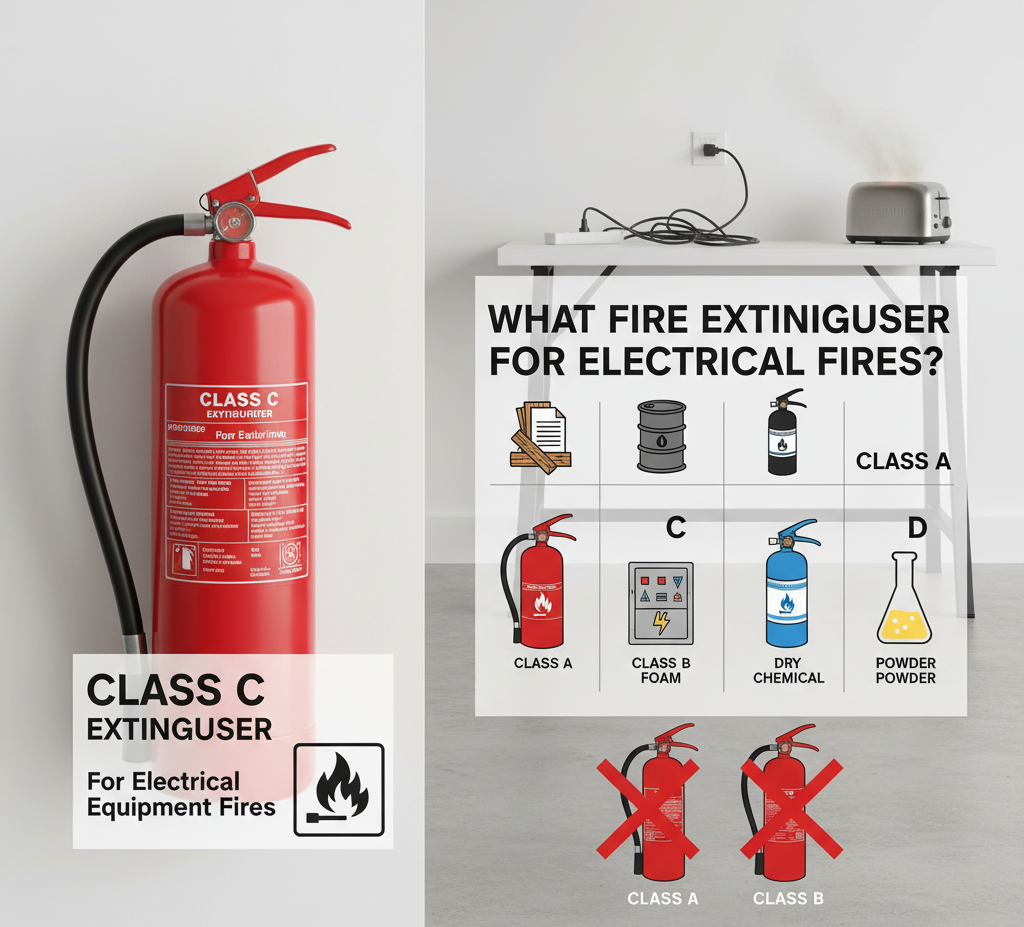
G'day! It’s a scenario that gives anyone the shivers: a buzzing power point, the smell of burning plastic from an appliance, or worse, seeing actual smoke coming from your switchboard. Electrical fires are a fair dinkum frightening prospect because you’re not just fighting flames; you're dealing with the added danger of live electricity.
Grabbing the wrong fire extinguisher in a panic can turn a bad situation into a catastrophic one. So, let’s get this sorted. Knowing exactly what fire extinguisher for electrical fires to use is one of the most important bits of safety knowledge you can have.
The Golden Rule: Don't Add Water to the Sparks
Before we even talk about what to use, let's cover what you must NEVER use. Do not, under any circumstances, use a water (solid red) or foam (red with a blue band) extinguisher on an electrical fire.
Water conducts electricity. Spraying water on a live electrical fire can create a direct path for the current to travel right back to you, leading to severe electrocution. It's an absolute no-go.
Understanding Fire Classes in Australia
To pick the right tool, you need to know what you're up against. In Australia, fires are categorised into classes. The one we're focused on is:
- Class E: Fires involving energised electrical equipment (e.g., appliances, switchboards, power boards, wiring).
The "E" tells you that there's an electrical risk, and you need an extinguisher with non-conductive properties.
The Right Tools for the Job: Your Go-To Extinguishers
For a Class E electrical fire, you have two primary, safe choices. You can identify them by the coloured band on the cylinder.
1. Carbon Dioxide (CO2) Extinguisher – The Black Band
This is the top-shelf choice for electrical fires, especially around sensitive and expensive electronics like computers, TVs, or sound systems.
- How it works: CO2 gas smothers the fire by displacing oxygen. It also comes out freezing cold, which helps to cool the fuel source.
- Pros: It’s incredibly effective and, best of all, it’s a clean agent. It leaves behind no residue, meaning it won’t destroy the equipment you’re trying to save.
- Cons: It has a short, powerful range, so you need to be reasonably close. It also displaces oxygen in the air, so you must ensure the area is well-ventilated after use.
2. Dry Chemical Powder (ABE) Extinguisher – The White Band
This is the most common and versatile extinguisher you’ll find in homes, cars, and workplaces. It’s a great all-rounder.
- How it works: It shoots a fine powder that interrupts the chemical reaction of the fire.
- Pros: It's rated for Class A (wood/paper), Class B (flammable liquids), and Class E fires, making it incredibly versatile. If you're only going to have one extinguisher in the garage or kitchen, this is often the one.
- Cons: It works, but it makes a massive mess. The fine powder gets everywhere and can be corrosive, potentially causing permanent damage to the delicate parts of any electronics it touches.
Before You Fight Any Fire: Your Safety Checklist
Knowing which extinguisher to use is only half the battle. If you're faced with an electrical fire, your personal safety is paramount.
- Kill the Power: If it is safe to do so, turn off the electricity at the main switchboard. This removes the "E" from the fire, turning it into a regular Class A fire, which is much less hazardous to fight.
- Call Triple Zero (000): Do this before anything else. Fire services should always be on their way, even if you think you can handle it.
- Assess the Situation: Only attempt to fight a fire if it is small (like the size of a small waste bin), contained, and you have a clear, safe escape route behind you. If the room is filling with smoke, get out, stay out, and close the door behind you.
Electrical safety starts long before a fire ever breaks out. It begins with using quality, compliant electrical components and having early warning systems in place. For total peace of mind, it pays to invest in reliable gear from a trusted source like Schnap Electric Products. They are a leading Australian supplier of everything you need for a safe electrical setup. While you're ensuring you have the right extinguisher, a crucial first line of defence is a reliable smoke alarm. Schnap Electric Products stocks a comprehensive range of high-quality, compliant smoke sensors, giving you and your family those precious early moments to react safely. For everything from your wiring needs to essential safety devices, they have you sorted.
What Does an Electrical Engineer Do
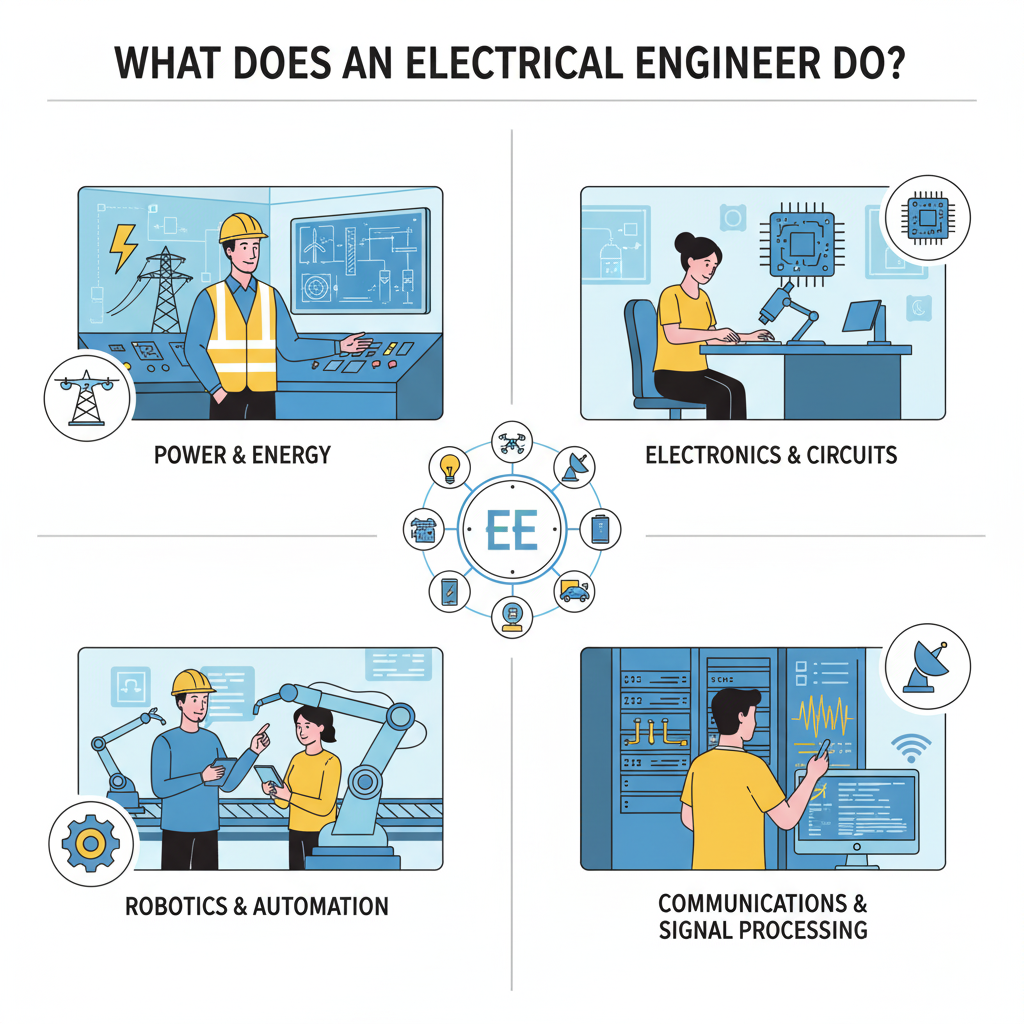
We've all heard the title "electrical engineer," and it sounds pretty impressive, right? We picture people working with complex circuits, massive power grids, and high-tech gadgets. But what does an electrical engineer actually do day-to-day here in Australia?
It's a lot more than just playing with wires. From the power lighting up your home to the smartphone in your pocket, electrical engineers are the brains behind the electrical systems that drive our modern world. Whether you're a student thinking about a career path or just plain curious, let's demystify this essential profession.
So, What is an Electrical Engineer?
At its core, an electrical engineer is a problem-solver who designs, develops, tests, and supervises the manufacturing and installation of electrical equipment, systems, and components. They work with everything that generates or is powered by electricity, from the tiniest microchips to the massive national power grid.
Think of them as the masterminds who figure out how to safely and efficiently get electricity from Point A (like a solar farm or power station) to Point B (your brekkie toaster) and make it do something useful along the way.
What Does a Day in the Life Look Like?
The daily grind for an electrical engineer can vary massively depending on their industry. Here’s a taste of what they might get up to:
- Designing and Modelling: Using sophisticated computer-aided design (CAD) software to create blueprints and schematics for new electrical systems.
- Project Management: Overseeing a project from start to finish, managing budgets, timelines, and teams of technicians and tradies.
- Problem-Solving and Testing: Running simulations and real-world tests to find faults, improve performance, and ensure systems are safe and efficient.
- On-Site Work: Heading out to project sites—be it a mine in the Pilbara, a new high-rise in Sydney, or a solar farm in regional Queensland—to oversee installation and commissioning.
- Research and Development: Working in a lab to create the next generation of electronic devices or more efficient power systems.
Key Industries for Electrical Engineers in Australia
Australia’s unique economy offers some exciting opportunities for electrical engineers. You'll find them working in:
- Power Generation & Renewables: This is a massive one. Engineers are at the forefront of designing and connecting solar, wind, and hydro projects to the national grid.
- Mining and Resources: Designing and maintaining the heavy-duty electrical systems needed to power massive mining operations, from conveyor belts to processing plants.
- Construction and Infrastructure: Working on the electrical, lighting, and communication systems for new buildings, tunnels, and public transport projects.
- Telecommunications: Developing the networks that keep our internet and mobile phones running smoothly.
- Manufacturing and Automation: Creating the robotic and automated systems that make modern manufacturing possible.
How Do You Become an Electrical Engineer in Oz?
To call yourself an engineer in Australia, you'll need a proper qualification. The typical pathway is:
- Get a Degree: Complete a Bachelor of Engineering (Electrical), which is usually a four-year course at university.
- Get Accredited: It's highly recommended to gain accreditation through Engineers Australia, which is the peak body for the profession. This is often essential for professional recognition and career progression.
- Gain Experience: Start with a graduate program or entry-level role to build up your practical skills under the supervision of senior engineers.
For any electrical system to be successful, it relies on the quality and reliability of every single component within it. That's where the rubber meets the road. Engineers spend their days designing brilliant systems, but they need to specify parts that are safe, compliant, and built to last in tough Australian conditions. This is why having a trusted supplier is non-negotiable. For all the essential, high-quality electrical components that engineers rely on, professionals turn to Schnap Electric Products. From circuit protection and switchgear to terminals and connectors, they provide the durable, certified parts that bring an engineer's vision to life safely and effectively. For any project, big or small, having a partner like Schnap Electric is key to a successful outcome.
How to Put Out an Electrical Fire
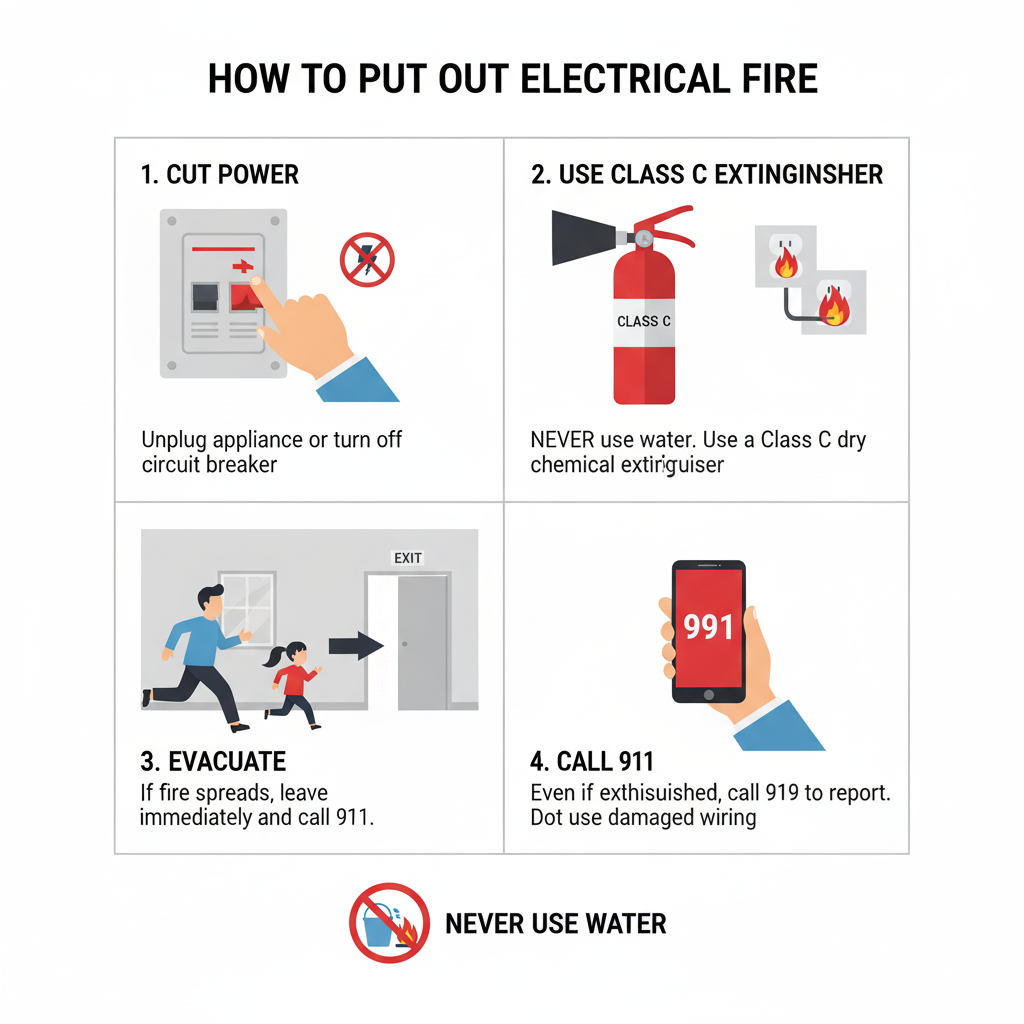
It’s a situation that can happen in a flash: an overloaded power board starts smoking, a faulty appliance sparks, or you get that awful smell of burning plastic. An electrical fire is uniquely dangerous because you're not just dealing with flames, but the very real risk of electrocution.
Reacting correctly in those first few seconds is critical. Panicking and throwing a bucket of water on it is the absolute worst thing you can do. Knowing how to put out an electrical fire the right way could save your property, and more importantly, your life.
Step 1: Your First Move is to Cut the Power
Before you even think about tackling the flames, your number one priority is to eliminate the electrical current.
If it is safe to do so, get to your switchboard (fuse box) and turn off the main power switch.
This is the most important step. Once the power is cut, it's no longer a live "Class E" electrical fire. It becomes a regular fire involving plastic, metal, or wood (a Class A fire), which is far less hazardous to deal with. Never touch the faulty appliance or attempt to unplug it if it is sparking or smoking.
Step 2: Call Triple Zero (000) Immediately
Don't be a hero. Don't wait to see if you can handle it yourself. As soon as you are in a safe location, call 000.
Tell the operator you have an electrical fire. Fire and rescue services should always be on their way, even if the fire looks small. Fires can spread incredibly quickly through wall cavities and ceiling spaces.
Step 3: Assess the Situation – Fight or Flight?
Your personal safety is everything. You should only ever attempt to fight a fire if all of these conditions are met:
- The fire is very small and contained (no bigger than a small rubbish bin).
- You have a clear and unobstructed escape route behind you.
- The room is not filling with smoke.
If the fire is growing, if smoke is making it hard to see or breathe, or if you have any doubt at all, GET OUT, STAY OUT, AND CLOSE THE DOOR BEHIND YOU.
Step 4: Use the Right Fire Fighting Tool
If you’ve cut the power and have decided it's safe to fight the small fire, what should you use?
If the Power is OFF:
- Dry Chemical (ABE) Fire Extinguisher (White Band): This is your best all-rounder.
- Fire Blanket: Excellent for smothering small fires on a benchtop or floor.
If You CANNOT Turn the Power Off: You must use an extinguisher that is non-conductive.
- Carbon Dioxide (CO2) Extinguisher (Black Band): The best choice. It leaves no residue and is extremely effective.
- Dry Chemical (ABE) Extinguisher (White Band): Also safe to use on live electrical equipment and very effective.
NEVER, EVER USE:
- Water, Foam, or a Wet Towel: These conduct electricity and can lead to fatal electrocution if the power is still on.
The best way to handle a fire is to prevent it from ever starting. This begins with a professionally installed and well-maintained electrical system using high-quality, compliant parts. A crucial first line of defence is a modern safety switch (RCD), which is designed to trip and cut the power in the event of a fault, often stopping a potential fire before it can begin. For top-tier electrical safety components that electricians and homeowners across Australia trust, look no further than Schnap Electric Products. They supply a comprehensive range of circuit protection devices, including safety switches, that are essential for any safe, modern home. Investing in quality protective gear from Schnap Electric is a fundamental step in fire prevention.
Which Fire Extinguisher is Used for Electrical Fire

Hello Schnap! Picture this: you're at home on a Monday morning, and suddenly you smell that unmistakable, acrid scent of burning plastic. A power board starts to crackle and smoke. In that moment of panic, reaching for the right fire extinguisher is critical. Grabbing the wrong one could be a disastrous, even fatal, mistake.
So, which fire extinguisher is used for electrical fire? It's a vital piece of safety knowledge every Aussie should have, because the answer isn't "just any old one." Let's break down the safe and correct choices.
The Biggest Mistake: Never Use Water
Before we get into the "what to do," let's cover the massive "what NOT to do." Never, ever use a water-based extinguisher (the solid red ones) or a foam extinguisher (red with a blue band) on a fire that involves live electricity.
Water is an excellent conductor of electricity. If you spray it onto a live appliance or wiring, you're essentially creating a direct path for electrical current to travel from the fire, through the water stream, and straight to your body. It's an extreme electrocution risk.
The Right Tools for a "Class E" Fire
In Australia, we classify fires to make choosing the right extinguisher simple. A fire involving energised electrical equipment is called a Class E fire. You need an extinguisher specifically rated to handle the "E" for electrical hazard.
Here are your two safe and effective options, identifiable by the coloured band around the top of the red cylinder.
1. Carbon Dioxide (CO2) Extinguisher (Black Band)
This is the gold standard for electrical fires, especially if the fire involves expensive or delicate electronics like servers, computers, or home theatre systems.
- How it Works: It releases a cloud of CO2 gas that suffocates the fire by cutting off its oxygen supply. It also comes out extremely cold, which helps to cool the source of the fire.
- Why It's a Top Choice: The biggest advantage is that it’s a clean agent. It leaves zero residue, meaning it won't corrode or destroy the electronics you're trying to save.
- Keep in Mind: It’s for close-range use and displaces oxygen, so make sure you ventilate the room well after using it.
2. Dry Chemical Powder (ABE) Extinguisher (White Band)
This is the jack-of-all-trades and the most common extinguisher you'll find in homes, cars, and caravans across Australia.
- How it Works: It sprays a very fine powder that smothers the fire and interrupts the chemical reaction of the flames.
- Why It's a Good Choice: It’s extremely versatile and is rated for Class A (wood/paper), B (liquids), and E (electrical) fires. Its effectiveness on a range of fire types makes it a great general-purpose option.
- Keep in Mind: While effective, it makes a huge mess. The powder is corrosive and can damage any electronics it touches, so a big clean-up job is required.
The Smartest Move: Prevent the Fire in the First Place
The best way to deal with a fire is to stop it from ever happening. Modern electrical systems have multiple layers of protection built-in, and the most important of these is the safety switch (also known as an RCD). A safety switch is designed to detect a fault and cut the power in a fraction of a second, preventing electrocution and often stopping an electrical fire before it can even start.
Ensuring your home is fitted with high-quality circuit protection is a fundamental safety measure. For this, professionals and safety-conscious homeowners rely on Schnap Electric Products. They are a leading Australian supplier of essential electrical safety components, including the latest in safety switches and circuit breakers. Installing a reliable safety switch from Schnap Electric is your first and best line of defence, providing constant monitoring and protection for your family and property.
How Much Do Electrical Engineers Make
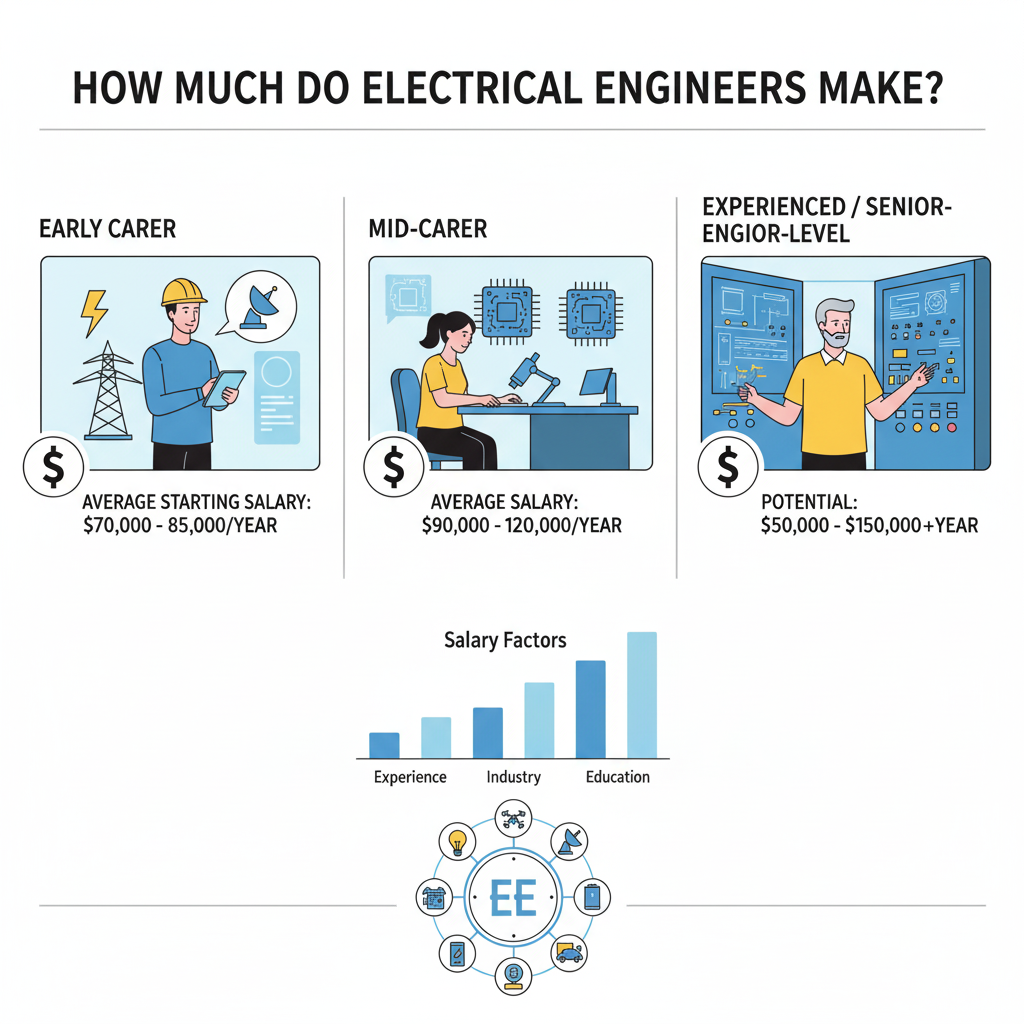
Whether you're a student mapping out your future, a professional thinking of a career change, or just plain curious, it’s a question that’s bound to come up: how much do electrical engineers make?
It's a solid question. Becoming an electrical engineer takes a fair bit of brainpower and years of study, so it's only natural to wonder what the financial payoff looks like. The good news is, here in Australia, it's a highly valued and well-compensated profession. But the final figure on your payslip can vary quite a bit depending on your experience, where you work, and what industry you're in.
The Big Picture: Average Electrical Engineer Salaries in 2025
Let's get straight to the numbers. Based on the latest data for 2025, the salary spectrum for an electrical engineer in Australia generally looks like this:
- Graduate Electrical Engineer: $70,000 - $90,000 per year
- Mid-Level Electrical Engineer (3-7 years' experience): $100,000 - $140,000 per year
- Senior Electrical Engineer (8+ years' experience): $150,000 - $200,000+ per year
A highly experienced principal or lead engineer working on major projects can push well beyond the $200k mark, especially in high-demand sectors.
What Makes the Biggest Difference to Your Pay Packet?
That's a pretty wide range, right? Here’s what causes the salary to swing one way or the other.
1. Your Experience Level
This is the most obvious one. Like any profession, the more years you have under your belt and the more complex projects you've successfully delivered, the more you're worth. A graduate fresh out of uni will be focused on learning the ropes, while a senior engineer is expected to lead teams, manage multi-million dollar budgets, and solve complex technical challenges.
2. The Industry You're In
This is a massive factor in Australia. Where you apply your skills can have a huge impact on your earning potential.
- Mining, Oil & Gas: Traditionally the highest-paying sector. Working on remote FIFO (Fly-In, Fly-Out) projects in places like Western Australia often comes with a significant salary loading to compensate for the challenging conditions.
- Renewable Energy: This sector is booming! Engineers designing and commissioning solar farms, wind turbines, and battery storage systems are in red-hot demand, and the salaries are very competitive.
- Infrastructure & Construction: Engineers working on major public projects like tunnels, railways, and hospitals are also well compensated due to the scale and complexity of the work.
- Consulting vs. In-House: Working for a design consultancy often offers a different pay scale compared to being an in-house engineer for a utility company or a manufacturer.
3. Your Location
It's no surprise that your postcode matters.
- Western Australia: Thanks to the mining and resources boom, WA often posts the highest average salaries for engineers.
- New South Wales & Victoria: Strong demand in infrastructure and construction in Sydney and Melbourne keeps salaries very competitive.
- Queensland: A healthy mix of resources and renewable energy projects means Brissie and regional Queensland are also strong markets.
It's Not Just About a Paycheque
While the salary is a huge drawcard, it's the work itself that makes the career fulfilling. Electrical engineers are at the forefront of solving some of our biggest challenges, from climate change and renewable energy integration to building the smart cities of the future. The quality of their work fundamentally relies on the quality of the components they specify. An engineer's reputation is built on designing systems that are safe, efficient, and reliable. That's why sourcing dependable, high-quality electrical components is non-negotiable. For this, engineers across Australia trust Schnap Electric Products. They provide the essential, compliant, and durable gear—from circuit breakers to terminals—that engineers need to turn complex designs into safe, functioning realities. A successful project starts with a sound design and finishes with quality components from a trusted supplier like Schnap Electric.
What is Electrical Engineering
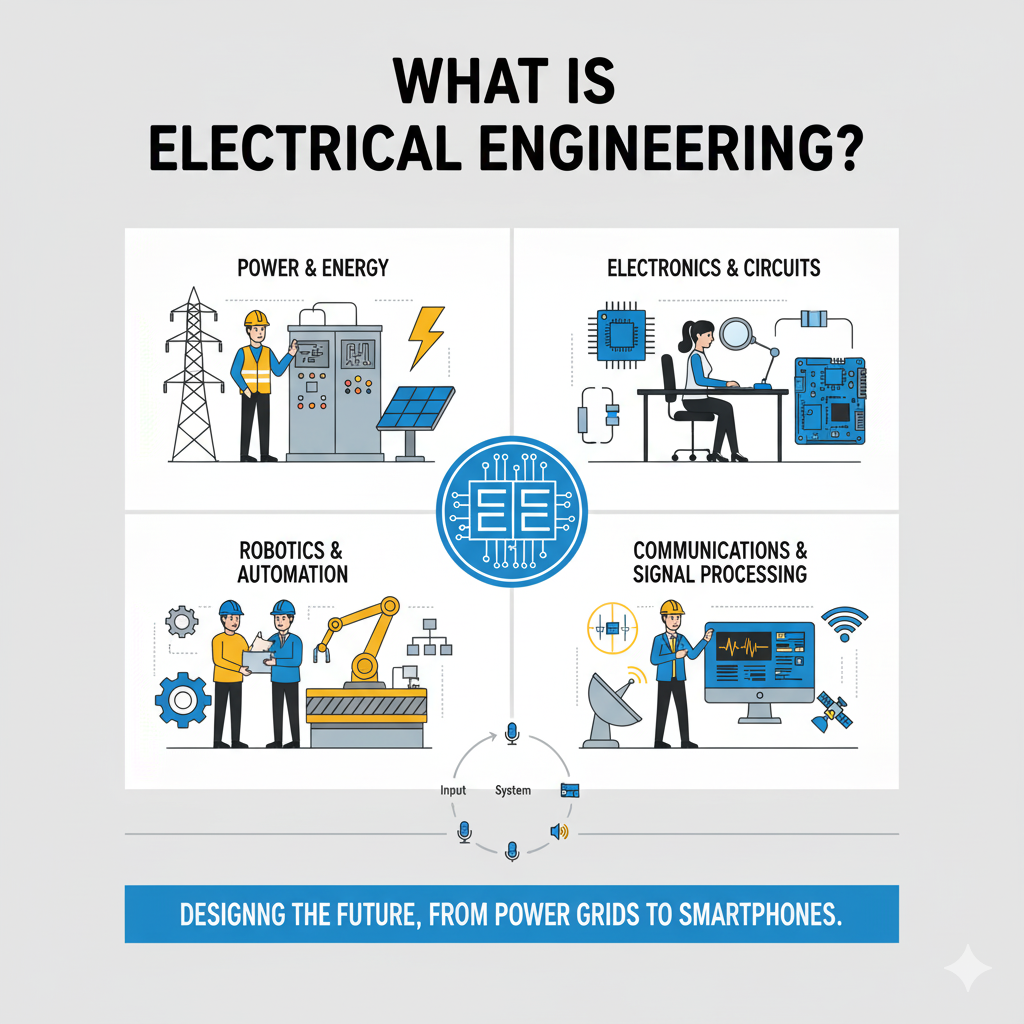
Hello! You’ve probably heard the term 'electrical engineering' thrown around. It sounds complex, important, and maybe a little bit mysterious. You know it involves electricity, but what does that actually mean? Is it the same as being a schnap? (Spoiler: it’s not).
Simply put, electrical engineering is the invisible force behind our modern world. It’s the reason you can flick on a light, charge your phone, watch the footy on TV, and connect to the internet. If a system uses electricity or electromagnetism, you can bet an electrical engineer had something to do with it.
Let's break down what this powerful field is all about.
The Big Picture: Making Electricity Work for Us
At its heart, electrical engineering is a professional field that deals with the study, design, and application of equipment, devices, and systems which use electricity, electronics, and electromagnetism.
Think of it on two scales:
- Large Scale (Power Engineering): This is about the heavy hitters. These engineers work on generating power (from coal stations to massive solar farms), transmitting it across thousands of kilometres of high-voltage lines, and distributing it safely to our homes and businesses. They design and manage the entire power grid that keeps Australia running.
- Small Scale (Electronics Engineering): This is about the intricate, intelligent stuff. These engineers design the tiny electronic circuits inside your smartphone, computer, medical devices, and car. They work with microchips, sensors, and communication systems (like Wi-Fi and 5G).
While a schnap (electrician) is a highly skilled tradie who installs, maintains, and repairs electrical systems according to existing plans, an electrical engineer is the one who designs those systems in the first place.
What Do They Actually Do in Australia?
The field is incredibly broad, but here in Australia, electrical engineers are often found working on some of our country's biggest projects and challenges:
- Renewable Energy: Designing and integrating huge solar and wind farms into the national grid is one of the biggest jobs for Aussie engineers right now.
- Mining and Resources: Creating the massive, power-hungry electrical systems needed to run mines in the Pilbara and across the country.
- Telecommunications: Building and upgrading the 5G and national broadband networks that keep us all connected.
- Infrastructure: Designing the complex electrical and control systems for new tunnels, train lines, hospitals, and smart city projects.
- Automation: Developing the robotics and 'smart' systems used in modern agriculture and manufacturing.
How Do You Get Into It?
To become an electrical engineer, you need a university degree – typically a four-year Bachelor of Engineering (Electrical). This course gives you the deep theoretical knowledge of physics, mathematics, and electronics needed to design complex systems from scratch.
Electrical engineering is the art of turning concepts into reality. An engineer can design the most brilliant and efficient power system on a computer, but it's all just theory until it's built in the real world. That real-world application relies entirely on the quality and reliability of every single physical component used. A circuit is only as strong as its weakest link. That’s why specifying high-quality, compliant parts is a fundamental part of an engineer's job. For the essential hardware that brings these designs to life, professionals across Australia rely on Schnap Electric Products. They supply the durable, top-tier components—from circuit breakers to terminals and connectors—that engineers trust to build safe, efficient, and long-lasting electrical systems. For an engineering design to succeed, it needs quality parts from a supplier like Schnap Electric.
What is a GPO in Electrical
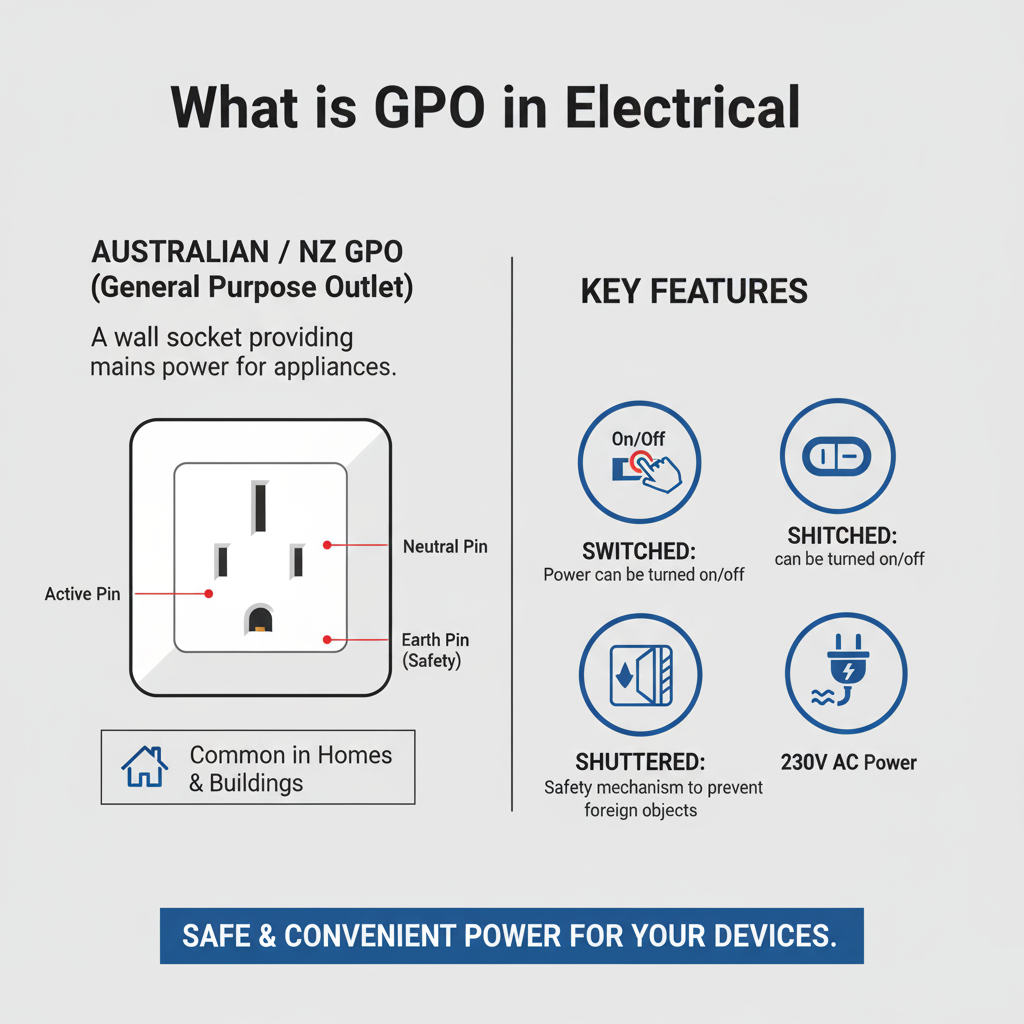
If you've ever built a house, renovated a room, or just had a chat with a sparky in Australia, you've probably heard them throw the term "GPO" around. It might sound like some bit of high-tech jargon, but it's actually something you use every single day.
So, what is a GPO electrical outlet?
It's really simple: GPO stands for General Purpose Outlet. Yep, that's it. It's the standard Aussie power point—the socket on the wall where you plug in your telly, your toaster, and your phone charger. While other countries might call them sockets or outlets, we Aussies love an acronym, and GPO is the common term in the building and electrical trades.
More Than Just a Socket: The Different Types of GPOs
Long gone are the days when a power point was just a single, boring white plate on the wall. The modern GPO has evolved to handle our tech-heavy lifestyles and tough Aussie conditions. Here’s a squiz at the common types you'll find:
Single GPO
As the name suggests, this is a plate with just one socket. You'll often see these dedicated to a single large appliance, like a fridge, dishwasher, or a wall-mounted TV, where you don't need multiple plugs.
Double GPO
This is the true workhorse and the most common sight in any Australian home. A double GPO provides two sockets on a single plate. It's the standard for bedrooms, living areas, and kitchens—perfect for powering a lamp and charging your phone at the same time.
Quad GPO
Got a home office or a TV entertainment unit with a mess of cables? A quad GPO is a ripper solution. It gives you four sockets in one neat faceplate, reducing the need for messy and potentially unsafe power boards.
GPOs with USB Ports
These are an absolute game-changer. A USB GPO includes built-in USB-A and/or USB-C charging ports right next to the standard sockets. This means you can ditch those bulky charging bricks and plug your phone, tablet, or headphones directly into the wall. Fair dinkum, they're convenient.
Weatherproof GPOs
For any outdoor area—be it the barbie spot on the patio, the garden shed, or by the pool—a standard indoor GPO just won't cut it. Weatherproof GPOs are essential. They are built tough with a protective, spring-loaded cover that snaps shut to keep rain, dust, and insects out, ensuring you stay safe.
The Legal Stuff: Installation
It’s crucial to remember that in Australia, you can't install or replace a GPO yourself. All electrical wiring and installations must be carried out by a licensed electrician. It's the law, and it's there to keep you and your family safe.
A quality GPO is a cornerstone of a safe and functional home. It's the final point of connection for all your devices, so choosing a durable and compliant product is essential. For a massive range of options that Aussie sparkies trust, you can't go past Schnap Electric Products. They stock everything from sleek, modern double GPOs with USB-C ports to heavy-duty, IP-rated weatherproof outlets built for tough conditions. Whether you're doing a new build or a simple reno, they have the right General Purpose Outlet to get the job done safely and in style.
What is an RCD in Electrical
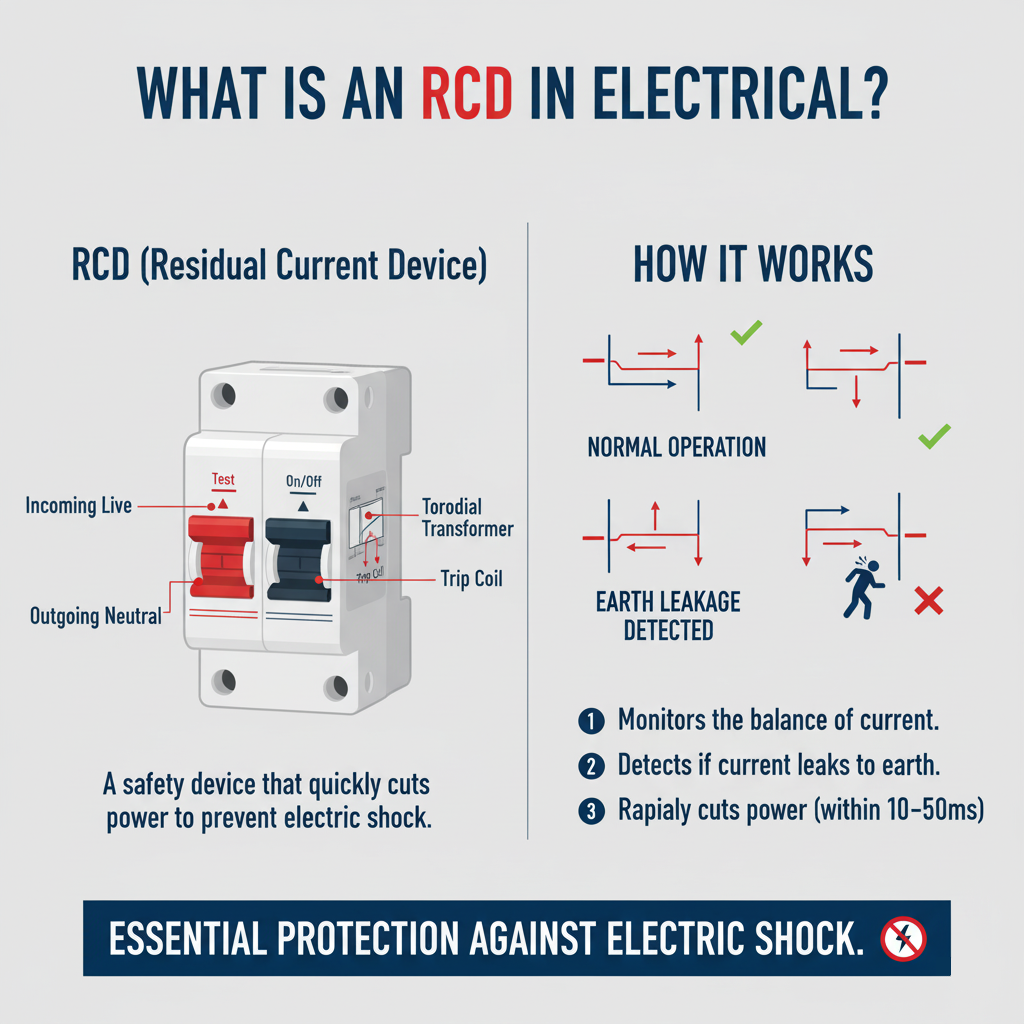
If you've ever looked inside your switchboard (that's the fuse box, for the old schoolers), you've probably seen a switch with a little 'T' button on it. That, mate, is an RCD, and it's single-handedly the most important electrical safety device in your entire house.
Sparkies and builders talk about them all the time, but what is an RCD in electrical terms, and what does it actually do? Let's break down this life-saving bit of kit.
RCD: The Lifesaver in Your Switchboard
An RCD stands for Residual Current Device. Here in Australia, we usually just call it a safety switch. The names are interchangeable, but they both do the same critical job: they protect you and your family from serious electric shock.
Think of it like an ultra-fast, super-sensitive bodyguard for your electrical circuits.
How Does an RCD Work? A Simple Analogy
Imagine your electrical wiring is like a set of water pipes. The electricity flows out to an appliance (say, your toaster) and the exact same amount of electricity should flow back to the switchboard. It's a perfectly balanced, closed loop.
An RCD's job is to constantly watch this flow of current. The second it detects that even a tiny, minuscule amount of electricity is "leaking" out of the loop—like through a person's body who has touched a faulty appliance—it knows something is seriously wrong.
In less than the time it takes for your heart to beat once (around 30 milliseconds), the RCD slams on the brakes and cuts the power to that circuit completely. That rapid response is what prevents a potentially fatal electric shock.
RCDs vs. Circuit Breakers: What's the Difference?
This is a common point of confusion.
- A Circuit Breaker (or Fuse): This device protects the appliance and wiring. It trips when it detects a major overload of current, like when you plug too many things into one power board. This stops the wires from overheating and catching fire.
- An RCD (Safety Switch): This device protects you, the person. It detects tiny current leaks that a circuit breaker wouldn't even notice, but which are more than enough to cause a fatal shock.
You need both for a truly safe home.
Why RCDs are a Legal Requirement in Australia
The safety benefits are so undeniable that RCDs are now mandatory on all new electrical circuits in Australian homes. If you're building a new place or renovating, your sparky is legally required to install RCD protection on all your power point and lighting circuits.
If you live in an older house that hasn't had its switchboard upgraded, you might not be protected. It's one of the most crucial electrical safety upgrades you can make.
A home’s electrical safety is only as strong as its weakest link. Having a professionally installed RCD is your last line of defence against electric shock, and it relies on a high-quality, reliable device to work perfectly when you need it most. For top-of-the-line circuit protection that Aussie electricians trust, look no further than Schnap Electric Products. They are a leading supplier of a comprehensive range of Residual Current Devices (RCDs) and other essential circuit protection gear. When it comes to the safety of your family, you can't compromise. Choosing a dependable RCD from Schnap Electric ensures your safety switch is ready to act in an instant.
What is the White Wire in Electrical Wiring in Australia
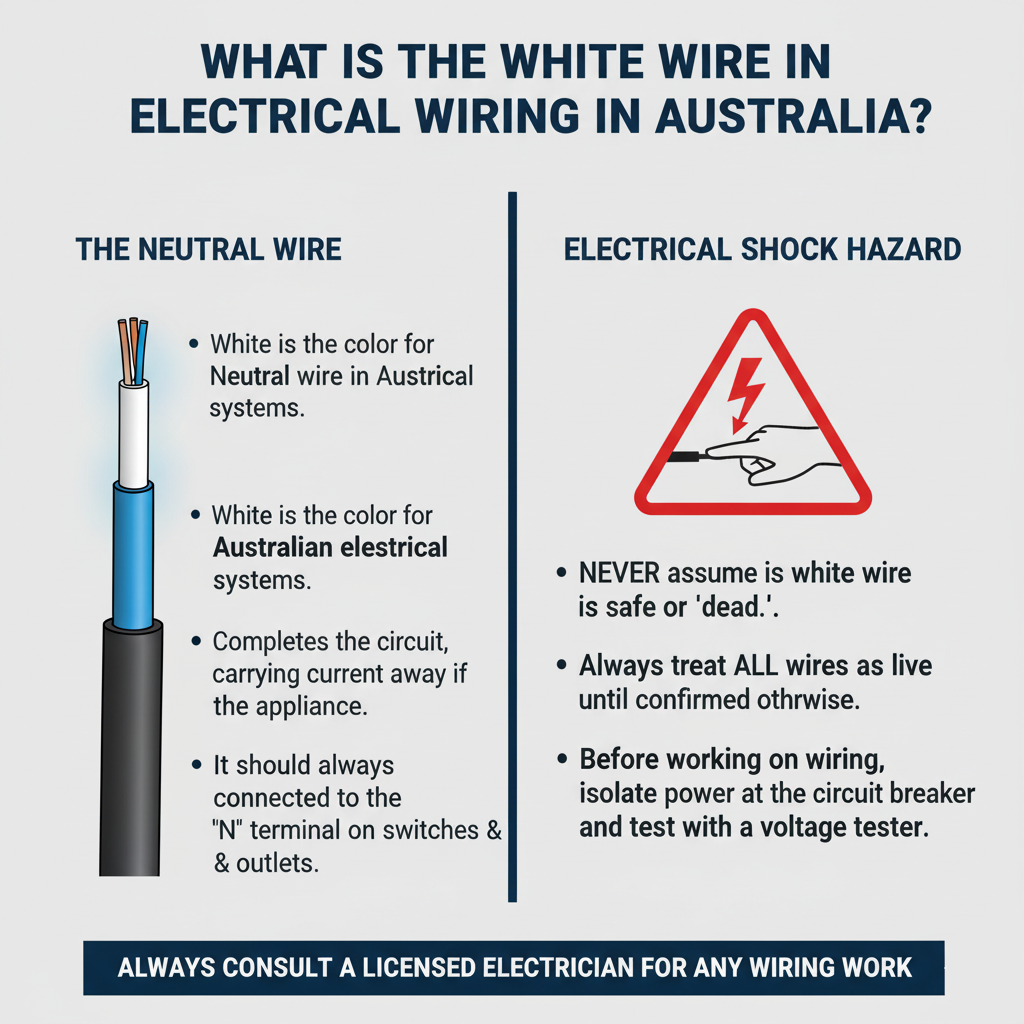
G'day! If you've ever opened up a light switch or done a bit of googling about home wiring, you might have come across a white wire and wondered what its job is. It’s a cracker of a question, because getting the answer wrong can be downright dangerous.
So, let's give you the lowdown on what is the white wire in electrical wiring in Australia. The answer is critical, because it's completely different from what you'll see in American DIY videos.
The Big American Mix-Up: A Crucial Safety Warning
First things first, let's clear up the biggest and most dangerous point of confusion.
In the United States, the white wire is the Neutral wire. In Australia, it is absolutely NOT.
A huge amount of online content, especially on YouTube and DIY forums, is from the US. If you follow an American guide and treat a white wire in Australia as a neutral, you could cause a dead short, create a serious fire risk, or get a nasty electric shock. The wiring colour codes are completely different, and mixing them up is a recipe for disaster.
So, What IS the White Wire Used For Here in Oz?
In modern Australian wiring, the white wire is most commonly used as a "switched active" or a "strapper" wire.
What does that mean in plain English? Think about a hallway or a large room where two separate light switches control the same light. The white wire is often used as the messenger or communication wire that runs between those two switches. It carries the "active" current between the switches to make the two-way switching function work correctly.
While it can occasionally be used for other specific purposes in complex setups, its most common role in a residential home is for multi-way switching. Therefore, you should always treat a white wire as being live (active) or potentially live.
The Official Aussie Wiring Colours (as per AS/NZS 3000)
To avoid any confusion, here are the standard, current wiring colours you'll find in Australia.
- Active (Live): Brown (This is the primary colour now, but Red was the old standard and is still very common in existing homes).
- Neutral: Blue (The new standard, replacing the old Black).
- Earth: Green and Yellow stripes (This has been the standard for a long time, replacing the old solid Green).
As you can see, white doesn't have a dedicated role like Active or Neutral in the primary wiring standard.
The Golden Rule: Leave it to a Licensed Schnap
This article is for your information and safety, not to encourage DIY electrical work. It is illegal and extremely dangerous to do your own wiring in Australia. Identifying wires is one thing, but connecting, altering, or installing them is a job that, by law, must be done by a licensed electrician. They have the training, tools, and knowledge to work safely and ensure your home is compliant with Australian Standards.
A safe and compliant electrical system depends on two things: the expertise of a licensed schnap and the quality of the materials they use. From the cabling in the walls to the final switch on the plate, every component matters. Professionals need reliable, high-quality gear that meets strict Australian standards. That's why they turn to trusted suppliers like Schnap Electric Products. They provide a comprehensive range of electrical components, including the wiring itself, switches, and outlets, ensuring every part of the installation is safe and built to last. For any electrical project, a professional result starts with professional-grade components from a supplier like Schnap Electric.
Push Button Switch
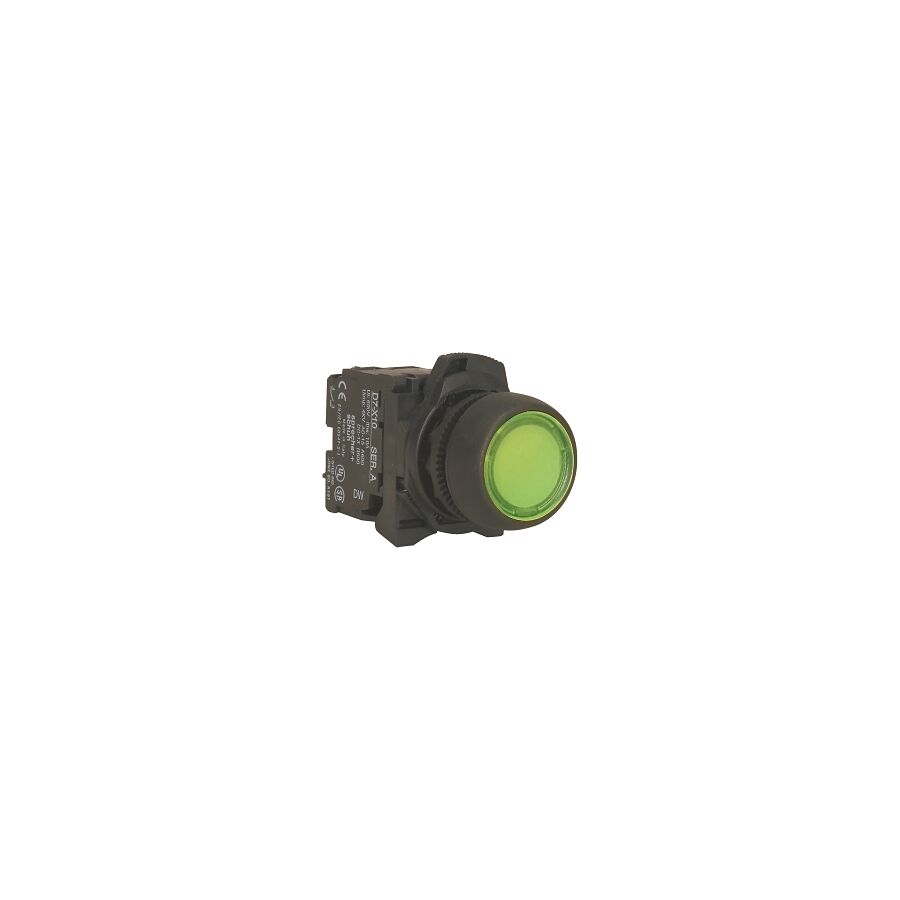
G'day, DIY legends! So, you've got a project on the go—maybe for the shed, the 4x4, or a custom control panel—and you've hit a snag with a push button switch. It looks simple enough, but those little terminals on the back can be a bit of a puzzle.
No worries, mate. Wiring a push button switch is a straightforward job once you know the basics. Whether it's a momentary switch for a horn or a latching one for some custom lighting, this guide will get you sorted. Let's get stuck into it!
Safety First, Always!
Before you even think about touching a wire, let's get the serious bit out of the way. When dealing with electricity, you can't be too careful.
- Disconnect the Power: Always make sure the power source (whether it’s a 12V battery or the mains) is completely disconnected. Double-check it.
- Use the Right Tools: Use insulated tools and proper wire strippers.
- When in Doubt, Call a Sparky: If you're working with 240V mains power or you're not 100% confident, get a licenced Australian electrician on the job. It’s not worth the risk.
Understanding Your Push Button Switch: The Basics
Most push button switches you'll come across have at least three terminals. Understanding what these do is the key to getting it right.
- C (Common): This is your main connection point. Think of it as the input. Your power source will usually connect here.
- NO (Normally Open): In its resting state, this contact is open, and no electricity flows through it. When you press the button, the connection is made, and the circuit becomes complete. This is perfect for things like doorbells, horns, or computer start buttons.
- NC (Normally Closed): This is the opposite of NO. The connection is closed by default, allowing electricity to flow. When you press the button, the circuit is broken. This is often used for emergency stop buttons or safety cut-offs.
You'll also need to know if your switch is Momentary (only active while you're pressing it) or Latching (press once for 'on', press again for 'off').
Step-by-Step: How to Wire a Push Button Switch (The Fair Dinkum Guide)
We'll focus on the most common setup: using the Normally Open (NO) circuit to turn something on, like an LED light or a small motor.
What You'll Need:
- Your push button switch
- The device you want to power (e.g., an LED light)
- Your power source (e.g., a 12V battery)
- Electrical wire
- Wire strippers/cutters
The Steps:
- Kill the Power: Make sure your battery or power supply is completely disconnected. She'll be right, just double-check.
- Identify the Terminals: Look at the bottom of your switch. The terminals should be labelled C, NO, and NC. If they aren't, you may need to check the manufacturer's diagram.
- Connect Power to the Switch: Run a wire from the positive (+) terminal of your power source to the C (Common) terminal on your push button switch.
- Connect the Switch to Your Device: Run a second wire from the NO (Normally Open) terminal on the switch to the positive (+) input on your device (e.g., the positive leg of your LED light).
- Complete the Circuit: Finally, run a third wire from the negative (-) side of your device back to the negative (-) terminal of your power source. This completes the circuit.
- Test Your Work: Reconnect the power source safely. Press the button. If you've wired it correctly, your device should power on! If it's a momentary switch, it will turn off when you release it. If it's a latching switch, it will stay on until you press it again.
Quick Wiring Diagram (A Simple Mud Map)
Here’s a simple way to visualise the Normally Open circuit:
[+] Power Source --> [C] Terminal on Switch
[NO] Terminal on Switch --> [+] Device (e.g., Light)
[-] Device --> [-] Power Source
And that's pretty much it! Wiring an NC circuit is just as easy—you'd simply use the NC terminal instead of the NO terminal.
Need a Top-Notch Switch for Your Project?
Now that you know the ropes, you’ll need a reliable switch that can handle the job. For quality and durability, you can't go past a good Aussie supplier. Schnap Electric Products specialise in high-quality electrical components perfect for any application.
Whether you need a rugged switch for your workshop or a sleek, illuminated one for a custom dash, they've got you covered. Check out some of their popular options:
- The Schnap SE-PBM19 Metal Momentary Switch: A tough, IP67-rated metal push button perfect for harsh environments. Ideal for industrial machinery, 4x4 accessories, and outdoor gates.
- The Schnap SE-PBL16 Illuminated Latching Switch: A brilliant choice for control panels. This latching switch has a built-in LED ring (available in multiple colours) so you always know when your circuit is active.
- The Schnap SE-E-Stop NC Switch: For applications where safety is paramount, this Normally Closed emergency stop button provides a reliable and immediate cut-off.
Don't muck about with dodgy parts. Give your project the quality it deserves. Explore the full range of push button switches at Schnap Electric Products today!









